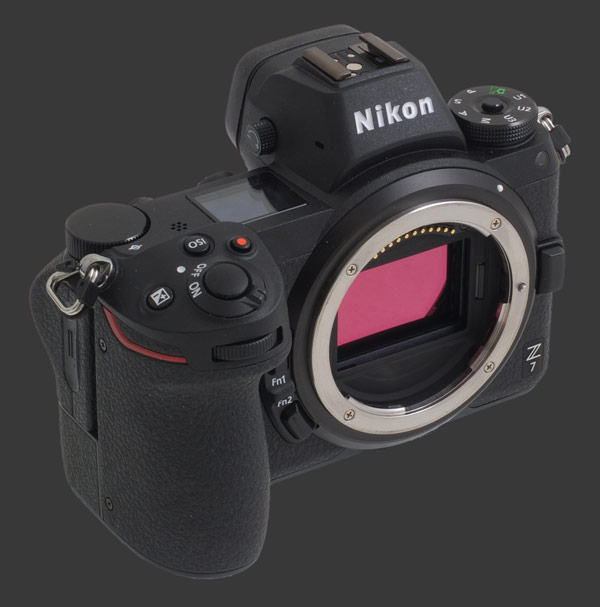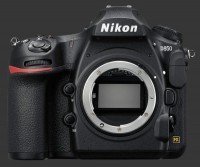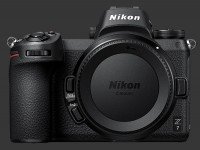Nikon Z7 Review
Nikon Z7 Performance - How well does it take pictures?
Ultimately, it is the image quality that makes a camera worth buying. For a digital SLR, image quality greatly depends on the lens used. While color, noise, contrast and exposure are properties of the camera, distortion, vignetting and chromatic aberrations are properties of the lens. Sharpness depends on the weakest link. So, the camera cannot capture more details than the lens lets through. Conversely, a lens can transmit a greater amount of details than the sensor can capture.
Image Noise & Sharpness
Image quality from the Nikon Z7 is outstanding given the high resolution of its sensor. There is no anti-alias filter to soften details and so this mirrorless is capable of capturing minute details. 46 megapixels makes for a very dense sensor and so pixels are smaller than on many full-frame digital cameras. For this reason, the Z7 and similarly the D850, have higher per-pixel noise and somewhat narrower ISO sensitivity range.
Output from the Nikon Z7 is of outstanding quality. Images taken from ISO 32 to 800 show virtually no noise. Given a resolution of 46 megapixels, this translates into very large prints with impecable details. Poster-sized prints are no problem for the Z7 which puts it close to the performance of medium format digital cameras in a much smaller form-factor.

Only a hint of noise starts appearing at ISO 1600 which is only truly visible when seen at 100% or on maximum-sized prints. The finest details are clearly preserved at that sensitivity, while preserving dynamic-range, contrast and color. Even on a large 24" x 18" print, viewers would be hard-pressed to see any noise.
The first stop that begins to affect details is ISO 3200 which shows a small amount of ver fine luminance noise. The edges of the finest details start softening from noise-reduction combatting noise. At that point, maximum print sizes drop by a couple of inches. Still, moderately large prints remain very nice and sharp. Pushing on to ISO 6400, image noise increases a little but it remains a gradual step.
At ISO 12800, the Nikon Z7 starts to show some chroma noise on top of the luminance noise which increases noticeably compared to ISO 6400. Even so, with 46 MP, the difference is only meaningful for large prints. A mid-size one, say 18" x 12" stays completely usable. While contrast is still very good, colors shift slightly towards green as chrome noise dominates in that channel. The last standard ISO of 25600 shows a noticeable jump in image-noise, reducing potential print sizes to typical mid-size prints.
Sharpness from the Z7 is excellent. Even more crucial is that this camera introduces an entirely new system with lenses designed with the necessary resolving power. Recall that with the D850, Nikon published a list of recommended lenses. These are the same lens that should be used with the F-to-Z mount adapter to get suitable sharpness with the Z7. Otherwise, choice is limited to any a few yet completely suitable native Z-mount lenses.
There are more parameters than ever to control image rendition. Sharpness itself is controlled in ¼ steps along a -3 to 9 scale. The steps are extremely fine with a default that depends on the selected Photo Style. A setting of +2 gives optimal sharpness without any artifacts. One can easily push this until +3 for added sharpness with minimal impact.
The Nikon Z7 introduces a separate control for additional sharpness in mid-tones. This is available on a -5 to +5 scale, also in ¼ steps. The increments are arbitrary and not in any particular unit, so consider this 41 total steps with very fine differences between them. Pushing this to around +1½ produces nice crisp details. The Clarity parameter that Nikon introduces a few generations ago works the same way but for micro-contrast. This time, optimal results are achieved around +2.

Metering & Color
Although it offers nearly the same set of metering modes as the D850, albeit with fewer sub-options, metering is done completely differently on a mirrorless than on a DSLR. The sensor is always on when previewing, so its entire output may be used to meter. This makes it possible to deliver more accurate metering which is seen on the Z7.
The default Multi-Segment metering of the Z7 is quite accurate and produces balanced exposures under reasonable conditions. Highlights are clipped when near the edge of the frame which is typical for segmented metering patterns. Exposure is rarely off by much and certainly improved over the D850. The Highlight Weighed metering mode is extremely conservative which tends to massively underexpose in the presence of very bright highlights. Spot and Average metering work exactly as expected.
Image parameters are plentiful and adjustable in very fine steps. There are six picture styles offering various degrees of realism. The Neutral style is closest to reality with natural yet slightly dull colors. Since Hue is now spot-on, only Saturation needs a boost of around +2 to give pleasing results. The Standard tone-curve for Neutral is slightly dull by default, so setting Contrast to +1½ produces images with plenty of punch without blacking out shadow details.
Automatic White-Balance from this mirrorless is quite good. There are a total of 4 Auto settings now! The 3 under Auto vary in how they deal with color-cast from typical of tungsten lighting. Auto 0 produces neutral colors, even under dim artificial light which is something the majority of Nikon DSLRs struggle with. It can leave a slight cast occasionally yet rarely a strong one. There are Auto 1 and Auto 2 settings too. The former keeps some of the warmth, the latter all of it. New to the Z7 is the Natural Light Auto setting. This one balances the natural light component, leaving artificial lights to their own color cast. This is mostly useful in mixed lighting situations.
Theoretically, the Z7 has the same dynamic-range as the D850. While its sensor is more modern, it uses on-sensor Phase-Detection pixels which become visible as bands in the darkest tones. This cuts off about a stop of usable dynamic-range from the Z7 compared to the D850. That was a class-leading performance and so the Z7 still has a very wide dynamic-range, just not as wide. At the base native ISO 64 sensitivity, the Z7 captures 13 usable stops. The lower expanded ISO 32 also captures with same dynamic-range, yet with even lower image-noise.

Speed & Autofocus
Digital cameras have been increasing in speed and mirrorless ones improving even faster than DSLRs. This means that the gap is getting narrower overall, with many performance aspects of mirrorless digital cameras surpassing what is possible with a flipping mirror and mechanical shutter. The aim of the Z7 is to match the performance of a full-frame DSLR.
The Nikon Z7 can capture 9 FPS bursts at full-resolution for 25 JPEG images or 18 RAW files. At such speed, the burst lasts just 2 or 3 seconds. One can reduce the frame-rate to 5.5 FPS to get full continuous autofocus and metering which gives right under 5 seconds. This is reasonable for such a high-resolution camera in terms of speed yet is probably insufficient for action photography. Given that the Z7 relies exclusively on a single XQD memory card, it is capable of clearing its buffer quite quickly, so only short pauses are needed between bursts.
This mirrorless is generally quite responsive. Dials and buttons get an instant response with changes to exposure parameters and other settings all happening instantly. The shutter-release requires some getting used to. It feels sticky only because of the Electronic First-Curtain Shutter (EFCS) which is on by default. What happens is that the shutter-release occurs immediately yet only the closing of the shutter is heard since that is mechanical. The electronic portion is completely silent. When Silent Shooting is enabled, then the Z7 is completely quiet.
The performance of the Nikon Z7 is characterized by the following numbers:
- Power On: Just under 1s. Good.
- Autofocus: ¼s even down to very low light. Excellent!
- Shutter-Lag: Nearly instant. Great.
- Shot-to-shot speed: ½s. Average.
- Instant Review: 1/2s. Still about average.
- Playback: Around ¼s to enter, less than ½s to exit. Good.
- Power Off: Instant. Very good.
The built-in Phase-Detect AF system of the Z7 is impressive. It is sensitive down to very low light levels and remains quick and precise. Since it’s on-sensor, it cannot be misaligned and so there is no need for AF Fine-Tuning. Even in dim indoor lighting, focus is locked in around ¼s. This is impressive for a mirrorless and is near the performance of high-end DSLRs.
Continuous AF works for targets that move relatively slowly and predictably. With fast subjects, the camera has trouble keeping up and often lags behind. This is particularly noticeable when using bright apertures that produce a shallow depth-of-field. Again, for the photography where speed is essential, this is not the right camera.
Battery-life is very short and drops noticeable as temperatures approach freezing. Even Airplane mode does not save it from poor battery-life. For a full day of shooting, at the very least 2 extra batteries are needed. Reducing the EVF and LCD brightness can help a little yet not by much since the circuitry dominates power consumption. Also, contrarily to a DSLR, reviewing images less does not make as much of a difference, since displays are on most of the time anyway.
Nikon Z7 Conclusion

Nikon entering the Full-Frame Mirrorless Digital Camera market was only a matter of time. The statement with the Z7 is that Nikon is taking a serious stance by introducing a completely new platform that could last for decades. Investment in a system is high and so this is a must for any high-end product. The new Z-mount is designed to have the widest opening and shortest flange distance among full-frame mirrorless which makes most lenses adaptable to it.
The Nikon Z7 itself delivers a very strong opening performance. Its 46 megapixels BSI-CMOS sensor manages to produce absolutely outstanding images and extrmely high quality full-wide 4K Ultra-HD video. Combined with a powerful EXPEED 6 processor, the imaging pipleline manages 9 FPS continuous shooting at full-resolution. Although the buffer-depth is short, this combination of image quality and speed is close to that of the class-leading Nikon D850
Nikon D850.
Image quality from the Z7 is among the best. Noise levels are extremely low through ISO 1600 and only gradually increase from there to 12800. This makes it possible to make very large prints even with low-light scenes. The dynamic-range from the sensor is very good, although one stop gets lost due to artifacts caused by the built-in 493-Point Phase-Detect AF system. Metering is among the best in class and consistently produces well-balanced exposures.
The image processing pipeline of this full-frame camera is the most sophisticated to date with very fine controls over detail and color rendition. Sharpness, color and contrast are all highly tunable to match the most demanding photographers. Even the Automatic White-Balance system is unusually reliable and manages to render neutral colors for the majority of scenes.
Although 9 FPS is sufficiently fast for most situations, the Z7 does not match the top DSLRs when it comes to action photography. Its 493-Point AF system is very reliable, sensitive and quite fast but is insuficiently fast to nail focus on every frame during a continuous burst. The camera itself though is extremely responsive and never holds the photographer back. The main performance drawback of very short battery-life is easy to overcome by purchasing additional batteries.
Ergonimics of the Nikon Z7 show a compromise in design. The camera has all of the controls needed to be operated efficiently while keeping some Nikon traditions which could be clearly improved. This gives a familiarity to existing Nikon users that are the primary market for the Z7, since only they have lenses mostly guaranteed to be adaptable with no loss of performance. This point is crucial since only 3 lenses were launched along the Z7 and Z6 twins.
The Z7 is the first Nikon interchangeable lens camera to offer built-in image stabilization which makes a world of difference. This 5-axis stabilization system is extremely reliable and performs very will at all focal-lengths. It can even perform 3-axis compensation while delagating the remaining to axis to VR elements inside adapted F-mount lenses.
A lof of emphasis has been put on the viewfinder experience. This is traditionally one of the major sore-points of mirrorless cameras, although nowadays EVFs have more advantages than inconveniences compared to OVFs. The 0.5" EVF in the Z7 offers a class-leading 3.7 megapixels with a large 0.8X magnification, 100% coverage and a built-in Eye-Start Sensor. Resolutionwise, this EVF is completely outstanding. The view is large and crisp with very natural contrast. All is not perfect though as the preview does not consistently manage to be Exposure Priority or show the resulting white-balance.
There is no doubt the Nikon Z7 is one of best mirrorless digital cameras out there. Despite being a first-generation product, Nikon has truly put a lot of effort into developping the new system and making their new Z7 a serious offering in the high-end mirrorless market.
 |
Please Support Neocamera
All information on Neocamera is provided free of charge yet running this website is a huge endeavor. Purchases made via affiliate links found throughout the site help keep it running and up-to-date. There is no additional cost to you, so please consider buying via these links to our affilates:
If you found any information on this site valuable and did not purchase via our affiliate links, please considering donating via PayPal:
Any amount will be greatly appreaciated. Thank you for your support!
Nikon Z7 Highlights

Sensor-Size: 36 x 24mm

Actual size when viewed at 100 DPI
| 46 Megapixels Mirrorless | ISO 32-102400 |
| Nikon Z Mount 1X FLM | Shutter 1/8000-30s |
| 5-Axis Built-in Stabilization, 5-Stop Improvement | Full manual controls, including Manual Focus |
| 0.50" Built-in EVF 3.7 Megapixels (0.80X) | Custom white-balance with 2 axis fine-tuning |
| Automatic Eye-Start sensor | Spot-Metering |
| 2 Axis Digital Level | Hot-Shoe |
| Weatherproof | Stereo audio input |
| Built-in Dust Reduction | Lithium-Ion Battery |
| 9 FPS Drive, 25 Images | XQD, CF Express Type B |
| 3840x2160 @ 30 FPS Video Recording | |
| 3.2" LCD 2.1 Megapixels |
Updates
2024.11.18

Best 2024 Photography Gifts for Every Budget
Great gifts for photographers and photo enthusiasts selected for every budget among the best products of 2024.
2024.08.07

Eye Protection Tips for Professional Photographers
The four main considerations for professional photographers regarding eyewear.
2024.07.14

Fujifilm X100VI Review
Flagship fixed-lens compact digital camera with a 40 MP sensor and Image-Stabilization, a first for the series. Retro design featuring dual control-dials, plus direct ISO, Shutter-Speed and EC dials. Its hybrid viewfinder can switch between EVF and OVF mode.
2024.05.09

Fujifilm GFX100 II Review
Flagship 102 Megapixels Medium-Format Mirrorless Digital Camera with 8-Stop 5-Axis IBIS, 8 FPS Drive, 8K Video and 400 MP Super-Resolution capture in a weatherproof and freezeproof body with dual control-dials and dual memory-card slots.
2024.04.03

Fujifilm X-T5 Review
Newest Fujifilm flagship boasting a 40 MP APS-C sensor, 5-axis IBIS with 7-stop efficiency, 15 FPS continuous drive, 6.2K Video capture, dual control-dials and dual SDXC UHS-II slots in a sturdy weatherproof and freezeproof body.
2023.11.20

Best Digital Cameras of 2023
Find out which are the Best Digital Cameras of 2023. All the new Mirrorless Digital Cameras from entry-level to high-end professional.
2023.07.10

Fujifilm X-H2 Review
40 Megapixels APS-C Hybrid Mirrorless Digital Camera with 7-stop IBIS. Fastest shutter ever and 8K video capture. Large builtin EVF with 0.8X magnification and 5.8 MP, plus an Eye-Start Sensor. Packed with features and large number of controls in a weatherproof and freezeproof body.
2023.05.07

Sony FE 20-70mm F/4G Review
Review of the unique Sony FE 20-70mm F/4G lens. The optical zoom of this lens spans ultra-wide-angle and medium focal-length coverage, making it one of the most versatile Full-Frame lenses on the market.
2023.01.15

Huion Inspiroy Dial 2 Review
Review of the Huion Inspiroy Dial 2 tablet, a medium sized drawing surface with dual dials and customizable buttons. Connects via USB-C or Bluetooth 5.0 with Windows, Linux and Android support.
2022.12.08

How to Pack for a Photo Trip
Find out how to pack for a travel photography trip, carry your gear safely while meeting airline regulations.
2022.11.13

Best Digital Cameras of 2022
The best digital cameras of 2022. A short list of the most outstanding models in their respective categories. Choose one for yourself or as a gift.
2022.09.21

Pentax DA* 60-250mm F/4 SDM Review
Review of the Pentax DA* 60-250mm F/4 SDM, the constant-aperture telephoto zoom with the highest zoom-ratio on the market.











